
A successful cloud governance program enables you to evaluate progress and value delivered to the organization regularly. You must do this evaluation as an initial benchmark and in ongoing monitoring. In short, you need to find out whether your investment in the cloud is paying off.
Today, we’ll go over some areas you should look at to test the “goodness” of your cloud.
Cloud Adoption Levels
This involves keeping track of metrics that determine the levels to which your organization has adopted the cloud. Look out for the following metrics:
- Proportion of existing projects that aren’t part of cloud transformation
- The percentage of service requests
- Level of subscription to enterprise cloud services
- Frequency of cloud service usage
- Number of subscribers per service
- Percentage of service-oriented architecture services consumed in the cloud
- Actual vs. expected cloud consumption
- Utilization level of services (PaaS, SaaS, IaaS)
- Consumption patterns
- Level of resource utilization
- Rate of change to subscriber count
- Number of cloud apps available through mobile devices
- Number of developers with self-service access to cloud resources
Operational Efficiency
To determine operational efficiency, you need to keep track of parameters that drive operational efficiency for the ongoing sustainability of cloud infrastructure and application components. Look out for the following:
- Number of reported incidents
- Average deployment time
- Average onboarding time
- Cost of overprovisioning
- Average VM time in the cloud environment
- Resource utilization average
Cloud Computing Governance Levels
You need to establish the level of cloud governance that your organization has put in place. Some metrics you should look out for include:
- The ratio of planned cloud services vs. actual cloud services
- The frequency of exceptions
- The average amount of time taken to train and educate staff on new services
- The total number of yearly disaster recovery tests per all apps
Cost Reduction
You can use the metrics falling under this category to drive the case for increased funding for cloud transformations in your organization. Measure the following:
- Percentage of IT human resource utilization
- Level of IT infrastructure resource utilization
- Proportion of the budget allocated to IT
- Cost reductions as a result of the move to the cloud
- Gap between cloud spend and budget
- Percentage of cloud resources repurposed from your organization’s existing resources
Business Value Alignment
You can use the indicators under business value alignment to show how cloud adoption aligns with your organization’s overall business goals. Look out for the following:
- Level of decrease in idle services
- Number of services registered vs. the number of services used
- Percentage of the business service level requirements met
- Number of potential customers that have unsubscribed
- Subscriptions vs. unsubscriptions ratio
- Total revenue generated by the IT department
- Number of automated cloud processes
- Average time of delivery of new services
Service-Driven Integration
You can use this metric to track how the cloud helps the organization build upon the existing service-based ecosystem. You need to track the following:
- Percentage of service provider exceptions vs. service provider integrations
- Percentage of unused services
- Number of services subscribed
- Level of redundant services
- SLAs affected by exceptions
- Service complaints
- Average time taken to resolve issues
- Average cloud application response time
Mitigation
You can use the indicators in this category to push preventive measures that help to avoid risks arising from cloud adoption. Keep track of the following:
- Security policy compliance percentage
- Percentage variance in schedule
- Number of unsubscribes
- Severity of exceptions
- Number of contacts with a single cloud provider
Conclusion
Use this as a scorecard for measuring cloud governance performance. The metrics you use will largely depend on your business goals.
Experience the leading hybrid cloud management and orchestration solution. Request a CloudBolt demo today.
Related Blogs

Top 3 cloud financial management challenges
Introduction As cloud costs continue to rise, comprising an ever-larger share of IT budgets, there is increasing executive scrutiny on…

